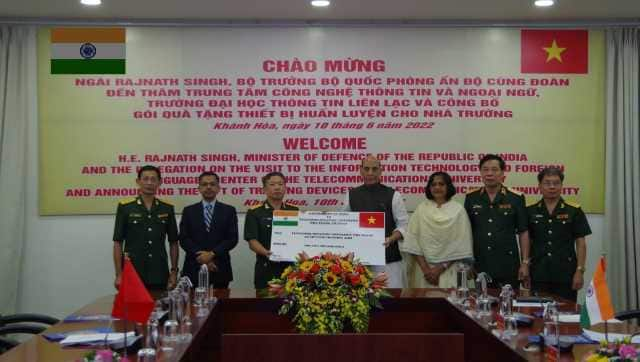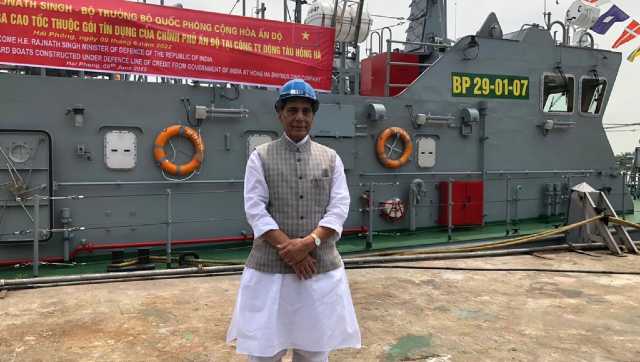Defence Minister Rajnath Singh embarked on a three-day visit to Hanoi, Vietnam, from 8-10 June 2022 with an aim to further strengthen the defence and maritime security cooperation between India and Vietnam. Vietnam is an important player in India’s Act East policy and also its Indo-Pacific vision. The defence minister handed over 12 high-speed guard boats to Vietnam. Five of those were built in India, and the rest in a Vietnamese shipyard under India’s $100 million Defence Line of Credit. The Defence Minister held extensive talks with his Vietnamese counterpart, General Phan Van Giang, with a focus on exploring new initiatives to further strengthen the defence engagements, besides exchanging views on regional and global issues of shared interest. During his Vietnam tour, he also visited training institutions of the country at Nha Trang, including the Telecommunication University where an Army Software Park is being established with a $5 million grant from India. India and Vietnam signed an MoU on mutual logistics support, the first such major agreement Hanoi has inked with any country for simplifying procedures for mutually-beneficial logistic support to allow militaries of the two sides to use each other’s bases for repair and replenishment of supplies. [caption id=“attachment_10845061” align=“alignnone” width=“640”]  Defence Miister Rajnath Singh visited the Telecommunication University at Nha Trang in Vietnam. Image courtesy Twitter handle of @rajnathsingh[/caption] The two countries also signed the ‘Joint Vision Statement on India-Vietnam Defence Partnership towards 2030’ which will “significantly enhance” the scope and scale of bilateral defence cooperation. The two sides also agreed to the early finalisation of the $500 million defence Line of Credit (LoC) extended to Vietnam by India. In a statement issued by the Indian defence ministry, it said, “The implementation of the projects under the LoC will add substantially to Vietnam’s defence capabilities and further Prime Minister Narendra Modi’s vision of ‘Make in India, Make for the World”. From the Indian end, gifting of two simulators and monetary grants towards setting up a language and IT laboratory at the Air Force Officers Training School for capacity building of the Vietnamese armed forces was also announced. These developments during the recent visit are indeed reflective of the fact that the India-Vietnam defence partnership is getting a push. The deepening of the defence ties has been a gradual process nonetheless. Vietnam was the first country in the Southeast Asian region with whom India had signed a Strategic Partnership Agreement in 2007, which from 2016 onwards after the visit of Prime Minister Narendra Modi to Vietnam has been elevated to a ‘Comprehensive Strategic Partnership’. In the early 2000s, both sides also signed a defence protocol through which Vietnam could procure military helicopters and equipment for the repair of Vietnamese aircraft. A provision was also made for facilitating the training of Vietnam’s military personnel by India. During the signing of the Comprehensive Strategic Partnership, India had reiterated “its commitment to provide necessary assistance in developing Vietnam’s defence capabilities as well as providing a new line of credit facility for the country.” Moreover, on the logistics front, the implementation of the $100 million Line of Credit for building high-speed patrol vessels to be used by the Vietnamese Border Guards is a classic example of India’s strategic support. The Vietnamese side has also appreciated India’s offer of $500 million Line of Credit to the local defence industry and agreed to accelerate procedures for its timely approval. Other defence engagements include joint military exercises, the latest of which was held in August 2021 when Indian and Vietnamese navies took part in a bilateral exercise in the South China Sea. India had deployed four frontline ships for the exercise, including INS Ranvijay and INS Kora, which were already on overseas deployment in Southeast Asia, the South China Sea and Western Pacific. Vietnam sent Vietnam People’s Navy (VPN) frigate VPNS Ly Thai To (HQ-012) for the exercise. Vietnam has always been a critical partner for India in its Southeast Asian diplomacy, both under its Look East policy and now in the era of the Act East policy. India was the only country to have supported Vietnam’s invasion of Cambodia in 1978. This had also stalled the process of India becoming a dialogue member in the ASEAN. [caption id=“attachment_10845161” align=“alignnone” width=“640”]  Defence Minister Rajnath Singh handed over 12 High Speed Guard Boats for Vietnam Border Guard at Hong Ha Shipyard in Vietnam on 9 Junetoday. Image courtesy @rajnathsingh [/caption] Vietnam’s approach or foreign policy orientation has evolved over the years and this can be seen at how the US-Vietnam relations have advanced over the years. The relationship is currently seen as mutually beneficial. This evolution of approach is also reflective in the way Vietnam handles China as well, where on the one hand it is one of the leading ASEAN countries to openly call out China for its aggressive stance in the disputed South China Sea, and on the other hand China is also the leading trading partner of Vietnam. With India on the contrary, Vietnam hardly has had any differences or conflict of opinions and the relation has been smooth. But as mentioned above this reform in attitude has provided the much-needed push for this bilateral relationship to make some substantial progress and not just remain a talking shop marked by some agreements and high-level visits. The wariness of other Southeast Asian countries when it comes to the growing influence in Southeast Asia of external powers like the US, Australia, India among others to balance a rising China is clearly visible, it is Vietnam which openly supports the idea of countries like the US, India taking more interest in the challenges that the region is facing. Vietnam has insisted on several forums that other stakeholders, even if not direct claimants in the South China Sea dispute like the US and India, should persuade China to work faster on a Code of Conduct in the South China Sea. Vietnam though also is keeping its relations with China intact, given the economic benefits, but also does not shy away from calling out Beijing when needed. India has ongoing oil exploration projects with PetroVietnam, although China continues to object to India’s oil exploration operations in areas offered by Vietnam and has on a number of occasions asked India to withdraw these projects. But Vietnam has lent its full support to India in this regard. This indeed makes Vietnam a valuable partner and player in the Indo-Pacific. India and Vietnam have agreed to strengthen bilateral cooperation in line with India’s Indo-Pacific Oceans Initiative and ASEAN’s Outlook on the Indo-Pacific in order to ensure shared security, growth and prosperity for the Indo-Pacific region. Another push to further boost the defence ties and defence industry collaboration has been for India’s drive of establishing its place as a potential exporter in the defence sector globally. This can be seen in Defence Minister Rajnath Singh’s statement at Hanoi: “The project is a glowing example of Prime Minister Narendra Modi’s vision of Make in India, Make for the World. The successful completion of the project, despite the challenges due to the Covid-19 pandemic, is a testimonial to the commitment and professional excellence of the Indian defence manufacturing sector as also of Hong Ha Shipyard and expressed confidence that it will be a precursor to many more cooperative defence projects between India and Vietnam in future.” Vietnam has mostly faced the brunt of Chinese aggression in the South China Sea since the 1970s — from China’s occupation of Paracels in 1974, to the occupation of Spratlys in the 1980s. This threat has only intensified in recent times. This looming threat and Vietnam’s reformed attitude and foreign policy orientation will only provide the much needed impetus to Vietnam to look at potential like-minded players in the Indo-Pacific like India. The author is an Associate Fellow with the Strategic Studies Programme of the Observer Research Foundation, New Delhi. Views expressed are personal. Read all the Latest News , Trending News , Cricket News , Bollywood News , India News and Entertainment News here. Follow us on Facebook, Twitter and Instagram.
Vietnam is an important player in India’s Act East policy and also its Indo-Pacific vision
Advertisement
End of Article


)

)
)
)
)
)
)
)
)



